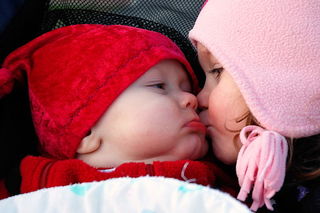Play
Infants' Instincts to Help, Share, and Comfort
Moral growth is promoted when we allow little ones to act on their instincts.
Posted September 30, 2018

An all-too-common belief in our culture —often held implicitly rather than explicitly — is that babies come into the world as either asocial (the “blank slate” belief) or antisocial (the “original sin” belief) and must be deliberately trained through reward, punishment, and coaxing to be helpful to others. However, parents who are truly attuned to their infants and toddlers are often amazed at the degree to which they behave in prosocial ways without any apparent training or even encouragement. [Note: Prosocial is the technical descriptor, opposite of antisocial, that psychologists commonly use to refer to behaviors aimed at benefiting others.]
An ever-growing mound of research supports the view that babies come to us prewired for prosociality. From an evolutionary perspective, this is not surprising. Throughout our biological history as humans, our survival, both as individuals and as groups, has depended on our helping one another. In the course of natural selection, individuals lacking a natural willingness or even eagerness to be helpful would have had great difficulty, over the long run, in being accepted and supported by the group, and, because of that, would have had great difficulty surviving or reproducing.
Researchers who study prosocial behavior in young children commonly categorize it into three relatively distinct but overlapping categories — helping, sharing (or giving), and comforting (Dunfield, 2014). In my last essay in this series, I presented evidence that little children begin voluntarily helping with housework and other chores almost as soon as they are able to move around, and, if those activities are accepted rather than discouraged, the helping becomes ever more effective as the children grow older. In this essay, I continue the theme of natural prosociality by summarizing some of the research on infants’ natural tendencies to share and comfort.
Sharing
Very early in life, infants routinely, without any special encouragement, begin to give objects to their caregivers and even to unfamiliar other adults and children. In a series of experiments conducted in the United States many years ago, every one of 111 infants who was tested, ages 12 to 18 months, spontaneously gave toys to an adult during brief sessions in a laboratory playroom (Hay & Murray, 1982; Rheingold & others, 1976). They gave not just to their mothers or fathers but also to an unfamiliar experimenter, and they gave new toys as frequently as familiar ones. They gave when an adult requested a toy by holding a hand out with palm up (the universal requesting posture), and they gave when no requests were made. Since then, research across cultures suggests that this early, natural tendency to give occurs everywhere. For example, in one study infants in a Ju/’hoansi hunter-gatherer community in Africa were observed to give objects regularly to others before the end of their first year of life (Bakeman & others, 1990).
In our culture, children’s early enjoyment of giving may be noticed by parents and others but is not much commented on. Books on childcare, for example, rarely mention it. In contrast, the Ju/’hoansi treat a child’s early giving as a crucial developmental milestone, much as we treat a child’s first words. The sharing of food and supplies marks the difference between life and death for these hunter-gatherers, and the culture ascribes great value to its system of giving and receiving, referred to as hxoro. Grandmothers are especially charged with the task of initiating infants into hxoro by encouraging their sharing, through games of back-and-forth giving of beads (Bakeman & others, 1990). Whether or not these games increase the infants’ tendencies to give was unknown at the time, but there is now good reason to believe that they do.
In a recent experiment in the United States, infants as young as 7 months old willingly gave toys and other objects to an unfamiliar adult (the experimenter) and the frequency of such giving increased after practice with games of give-and-take (Xu, Saether, & Sommerville, 2016). In the experiment, each infant was tested twice in a laboratory playroom, 7 to 14 days apart. The mothers of some of the infants were instructed to play give-and-take games (passing objects back and forth) with their infants during the period between the two tests, and other mothers were instructed to play games of dropping objects into a bucket during that period. The result was a great increase in spontaneous giving, in the second test compared to the first, for those in the give-and-take practice condition but not for those in the control (bucket) condition. In fact, playing the bucket game did not even result in an increase in the spontaneous dropping of things into buckets.
Apparently, giving is special not just in the sense that it appears early without training, but also in the sense that it increases dramatically when others seem to appreciate it and there is an opportunity to practice. In this way, giving appears to be like helping, as discussed in my previous post; it appears naturally but will persist and increase if it is welcomed by those to whom it is directed.
Comforting
Newborn babies, as young as 2 or 3 days old, reflexively cry and show other signs of distress in response to another baby’s crying. They show more distress to crying than to other equally loud and discordant sounds, and they even show more distress to recorded sounds of another infant’s crying than to recordings of their own crying (see Little et al., 2015). Researchers have suggested that this early natural tendency to feel discomfort in response to another’s discomfort is a foundation for the development of empathy and caring.
Recent research indicates that, by 8 months of age, infants no longer cry in response to another infants’ crying, but, instead, behave in ways that seem to comfort the other infant. Mitzi-Jane Little and her colleagues (2015) conducted an experiment in which 8-month-olds were brought into the laboratory in sets of three and placed in strollers, in a triangular arrangement, such that each of them could see the other two and could, with effort, reach out and touch either of them. In some cases the infants’ mothers were present, each (standing to the side of their infant, and in other cases not. The goal was to see how the other two infants would respond if any one of the three began to fuss or cry. The result was quite remarkable: In every case, the infants who were not fussing or crying looked directly at the distressed infant and, in many cases, behaved in ways that seemed to be designed to comfort that infant, such as vocalizing (e.g. cooing), waving, and reaching toward and sometimes touching the distressed infant. They did this whether or not their own mothers, who were instructed to remain passive, were present. These comforting responses caused the distressed infant to stop fussing or crying more than one-third of the time that they occurred.
As infants grow older and more mobile they begin to comfort distressed others in more complex ways, such as by giving objects that they think will be comforting (Hoffman, 2000; Knafo et al., 2008). By about two years old, young children are often quite effective at such comforting. For example, Martin Hoffman (2000) described a case in which 2-year-old David first attempted to comfort his crying friend by giving him his (David’s) own teddy bear. When that didn’t work, David ran to the next room and returned with his friend’s teddy bear and gave it to him. The friend hugged the bear and immediately stopped crying. To behave in such an effective manner, the child must not only feel bad about another’s discomfort but must also understand enough about the other person’s mind to know what will provide comfort.
Freedom and Acceptance as Prerequisite Conditions for Moral Development
A major theme of many of my essays in this blog is that freedom is a key ingredient to children’s healthy development. To an amazing degree, children know innately what they must do to develop in healthy ways, but we must permit and welcome those activities, and we must provide an environment that enables them to occur. This applies to physical, intellectual, emotional, and social development, as I have explained in many previous posts, and it also applies to moral development, as I have illustrated here and in a previous post.
-------
And now, what do you think about this? … This blog is, in part, a forum for discussion. Your questions, thoughts, stories, and opinions are treated respectfully by me and other readers, regardless of the degree to which we agree or disagree. Psychology Today no longer accepts comments on this site, but you can comment by going to my Facebook profile, where you will see a link to this post. If you don't see this post near the top of my timeline, just put the title of the post into the search option (click on the three-dot icon at the top of the timeline and then on the search icon that appears in the menu) and it will come up. By following me on Facebook you can comment on all of my posts and see others' comments. The discussion is often very interesting.
References
Bakeman, Adamson, Konner, & Barr (1990). !Kung infancy: The social context of object exploration. Child Development, 61,794-809.
Dunfield, K. (2014). A construct divided: Prosocial behavior as helping, sharing, and comforting subtypes. Frontiers in Psychology, 5, 1-13.
Hay, D. F., & Murray, P. (1982). Giving and requestion: Social facilitation of infants’ offers to adults. Infant Behavior and Development, 5, 301-310.
Hoffman, M. (2000). Empathy and moral development: Implications for caring and justice. Cambridge, England: Cambridge University Press.
Knafo et al. (2008). The developmental origins of a disposition toward empathy: Genetic and environmental contributions. Emotion, 8, 737-752.
Little, Bradley & McGrath (2015). Baby empathy: Infant distress and peer prosocial responses. Infant Mental Health Journal, 36, 446-458.
Rheingold, Hay & West (1976). Sharing in the second year of life. Child Development, 47, 1148-1158.
Xu, Saether, & Sommerville (2016). Experience facilitates the emergence of sharing behavior among 7.5-month-old infants. Developmental Psychology, 52, 1732-1743.




